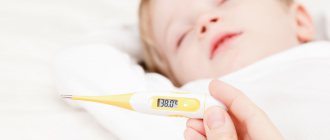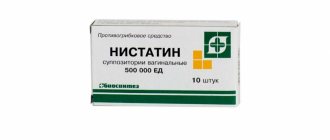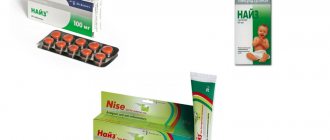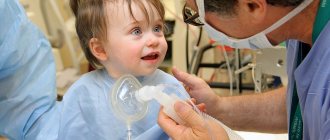Ambulance for children : 8 (812) 327-13-13 More details
High temperature is the most common cause of parental concern about the health of children. Often, measuring body temperature helps determine what is happening to the child - he is simply in a bad mood or the baby is still sick.
Where, with what and how should the temperature be measured?
Body temperature can be measured in a variety of places - in the armpit, in the rectum, in the mouth, in the external auditory canal (by the way, this is not theoretical reasoning - temperature is measured differently in different countries). In Russia, it is customary to measure the temperature under the armpit - this is exactly what should be done, since each option for measuring temperature has its own normal numbers, and your Russian doctor is accustomed to focusing on the armpit temperature. In turn, being in another country, it makes sense to inform the doctor that the temperature was measured under the armpit. Today, along with the usual mercury thermometers, electronic thermometers have become widespread. If you are not a very neat person, it is better to use just such a thermometer - one broken mercury thermometer will not create problems, but if you are used to breaking them regularly, the level of mercury vapor in your apartment can reach levels that are hazardous to health. Many people complain about the electronic thermometer not working correctly - there are several tricks that will help you cope with this problem. First, having bought an electronic thermometer, you should check it by measuring your temperature simultaneously with an electronic and mercury thermometer - the permissible difference should not exceed 0.2 º. Secondly, especially when measuring the temperature of children, the sound of the buzzer should be ignored and the thermometer should be held for another minute - the result will be more reliable. A few words about the so-called ear infrared thermometers: their undoubted advantages include the speed of measurement - only two seconds. However, in this case, at best, you get the temperature of the eardrum - enough to track the temperature dynamics, but may not satisfy your doctor, because the difference between ear and axillary temperatures is not a constant value and accurate conversion is impossible. In the worst (and very common) case, the ear canal is filled with wax - and the numbers on the display of your thermometer will have very little relation to the child’s body temperature. The same can be said about remote infrared thermometers for measuring forehead temperature - their accuracy is also far from ideal. Among the “advanced” new products, you can pay attention to the so-called. “Xiaomi smart children's thermometer - a review of this fashionable device can be found here https://news.rambler.ru/other/38877929-obzor-detskogo-termometra-xiaomi-vse-zhivy/ reviews from real users about convenience and accuracy are not bad. It is not difficult to buy this device today, but everything sold is “gray” supplies, since this device today does not have mandatory certification in accordance with Russian requirements.
Thus, the most accurate is still the good old mercury thermometer. Everyone knows how to use it, however, I would like to dwell on a few points. First, if your child is sweating, you should dry the armpit first. Secondly, when placing the thermometer, you should make sure that its tip is under the armpit and not sticking out. Thirdly, you should keep the thermometer under your arm for at least five minutes. Sometimes these five minutes can become a difficult test for the parent’s psyche - some children categorically do not like the thermometry procedure. In this case, you can use grandma's old method - place the thermometer not from front to back, but from back to front. In this case, the child does not see the thermometer sticking out and often behaves calmer. There is a known method of measuring temperature that does not require a thermometer at all - many parents (and especially grandmothers) often claim that they are able to determine the child’s temperature with an accuracy of tenths by touching it with their hand or lips. I categorically do not recommend using this method - the point is not only that such statements are, to put it mildly, somewhat exaggerated. Unfortunately, this method gives maximum errors precisely when knowing the exact body temperature is especially necessary - with the so-called “pale” fever (we will talk more about this unpleasant condition later).
Pharmacological properties of the drug Nurofen™ for children
The mechanism of action is due to inhibition of the synthesis of prostaglandins - mediators of pain, inflammation and temperature response. The drug has analgesic, antipyretic and anti-inflammatory effects, inhibits platelet aggregation. After oral administration, it is quickly and almost completely absorbed from the digestive tract. The maximum concentration of the active substance in the blood plasma is achieved 1–2 hours after administration. Ibuprofen is 90–99% bound to plasma proteins and penetrates into the synovial fluid. Metabolized in the liver to two inactive metabolites, which are quickly and almost completely excreted by the kidneys. A certain amount (10%) is excreted unchanged. The half-life is 2 hours.
How to give medicine to a child: rules and life hacks
Contents How to cut and crush tablets, capsules, patches?
What to do if you need very small doses of the drug?
Can long-acting drugs be divided into parts?
How to properly use patches for transdermal drug administration?
How to administer medications through feeding tubes?
A child cannot swallow a tablet or capsule whole, the drug does not have the required dosage and/or release form, the child has a “feeding” tube for feeding and administering drugs - how to give him medicine? How to do everything correctly, and most importantly, safely? Natalya Savva, Candidate of Medical Sciences, Associate Professor, Director of Scientific and Methodological Work of the Children's Palliative Foundation talks about this.
How to cut and crush tablets, capsules, patches?
The administration of a drug not according to its instructions is called off-label. This is any division of the tablet into parts, its crushing, dissolution, non-standard use of the solution from the ampoule. The effectiveness of drugs administered off-label may be reduced, and side effects may differ from those described in the instructions. But doctors often turn to such methods, not only in Russia, but throughout the world.
Nowadays there are many devices for dividing tablets into pieces and grinding them into powder. They are light, small, easy to carry, and can be purchased at a pharmacy or online. There are three main types of such devices:
- a device for dividing the tablet into parts (usually into two halves, then half can be divided further in half);
Photo: www.joom.com
- a device for grinding tablets (the simplest ones, like a mill, grind the tablet into powder, more complex ones can divide the tablet into equal parts and grind it into powder, there are devices with quiet operation for dividing and grinding at night);
Photo: dokmed.ru
- mortar and pestle (for grinding spices, can be used for grinding tablets, sold in regular stores).
Photo: ru.wikipedia.org
On sale you can find products “2 in 1” (for dividing and grinding tablets) and “3 in 1” (an organizer for storing tablets with a device for dividing and grinding).
Photo: market.yandex.ru
Photo: www.ozon.ru
What to do if you need very small doses of the drug?
Painkillers and other prescription drugs during a pandemic: how to get them?
How do I get a prescription for an elderly relative living alone? What to do if the pharmacy does not have the prescribed drug? What if the emergency doctor does not have the necessary medicine? Valeria Mikhailova Editorial team
Receiving palliative care
The tablet can be easily divided into four parts using the above devices or even a thin, sharp knife. Breaking the tablet into smaller pieces is difficult, especially if it is small or contains a large dose of medication and the child needs a very small dose. The contents of the capsule (powder or granules) are also difficult to divide into equal parts.
If such a situation arises, ask your local pediatrician to write a prescription to the pharmacy: there they can make a powder from tablets and capsules, and also make a liquid form of the drug from tablets (not from all tablets).
There are special pharmacies for extratemporal preparation (when the medicine is prepared in a pharmacy according to a doctor's prescription for a specific person) and a limited number of pharmacies that work with potent narcotic and psychotropic drugs. If the doctor has agreed and it is possible to buy a ready-made liquid form at the pharmacy (for parenteral administration of the medicine), use the solution from the ampoule (draw up with a small or insulin syringe).
If you need to divide the tablet into more than four parts, and there is no way to change the form of the drug, grind part of the tablet into powder, pour it into an insulin syringe without a needle and dose the desired part. The same can be done with the contents of the capsule. If you don’t have an insulin syringe, pour the crushed tablet or capsule contents onto a piece of paper in a square, evenly distribute the powder/granules into 2-6 squares and take the desired part.
Can long-acting drugs be divided into parts?
Tablets, capsules and patches designed for prolonged administration of the drug cannot be divided . They were invented to gradually introduce the drug into the body over a long period of time, so as not to take many pills often. If the integrity of the shell is broken, a large dose of the medicine will quickly enter the body. This may lead to an overdose. Therefore, the form and dosage of the drug must be selected initially so that there is no need to divide it into parts.
For example, extended-release morphine sulfate tablets
(MST) should never be divided into parts under any circumstances.
But extended-release morphine sulfate capsules
can be opened and the contents of the capsule can be used, divided into parts and mixed with water: each granule in the capsule of this particular drug is designed as a prolonged-release microtablet. And the capsule shell is intended only for storage (like sachets/sachets of the drug).
Important Always consult your doctor
How to properly use patches for transdermal (transdermal) drug administration?
Patches for percutaneous (transdermal) administration of drugs are divided into those that cannot be divided categorically (reservoir type) and those that are undesirable to be divided and cut (matrix).
Reservoir-type fentanyl patches must not be shared. It contains a clear opioid gel that penetrates the skin through a special semi-permeable membrane. If it is damaged, the absorption of the drug cannot be controlled, and rapid absorption will lead to serious overdose of the drug and severe side effects.
Matrix patches
(painkillers, anti-drooling) order in the right dosage so that you don’t have to divide them. As a last resort, if the situation is desperate, you can divide the matrix patch into parts, but first consult with your doctor, because dividing the expected effect may change.
Place the patch for percutaneous administration of the drug on a flat surface! There should be no damage or hair on the skin of the body or shoulder. Before applying the patch, if necessary, remove hair, rinse the skin with clean water (do not use products that irritate the skin) and dry the application area thoroughly.
The patch for percutaneous administration is sold in special thermal packaging: it must be glued to the skin immediately after removal, otherwise its effectiveness will decrease. To apply the patch, remove the protective film from it, and then press it firmly to the application site for 30 seconds. Make sure the patch fits snugly against your skin, especially around the edges. If the child sweats and the medication patch comes off immediately or when worn, cover it on top with a regular fixing patch.
The transdermal patch is protected by a waterproof film, so you can wear it in the shower (but not for long). The patch must be worn continuously for the time prescribed by the doctor (for example, 72 hours), after which it is replaced with a new one. Always apply a new transdermal patch to a different area of skin without touching the site of the previous application. The patch can be re-applied to the same application site no earlier than after 5-7 days.
How to administer medications through feeding tubes?
Doctors offer to put a gastrostomy on a child, but I’m afraid
Why parents are afraid - we’ll figure it out together with specialists and those who have already gone through the procedure Natalya Lavrinovich
Stomas
If the drug is administered incorrectly, the tube may become clogged. To prevent this from happening, follow some rules:
- Dissolve the crushed tablet or capsule contents in 10 ml of boiled water at room temperature. To administer the drug into the jejunum, dissolve it in sterile water.
- Flush the tube with water before and after administering the medication slowly, using the volume of water determined by your doctor. In children under 1-2 years old it is usually up to 10 ml, in children older - 15-20 ml. If the drug is administered into the stomach, use plain water, if into the jejunum, use sterile water.
- For flushing, use a syringe with a volume of at least 20 ml so as not to create high pressure from injection (the smaller the volume of the syringe, the higher the pressure). Flush the tube slowly and gently using an intermittent start-stop technique.
- Do not mix medications with food: the tube may become clogged, and if the food is poorly absorbed, the medication will be absorbed unpredictably. The scheme is as follows: food - rinsing - medicine - rinsing - food.
- If feeding is being given by drip, stop the infusion, administer the medication, rinse with water, and continue feeding.
- If you need to administer several drugs, administer them one at a time, doing at least minimal rinsing between them: they may interact with each other.
- Some drugs interact: for example, iron and zinc. They need to be administered at different times.
- There are drugs that can stick to the wall of the tube (carbamazepine, clonazepam, diazepam, phenytoin). Dissolve them with water (at least 30 ml).
- There are forms of the drugs that are highly viscous and can clog the tube. Dilute them with water (at least 30 ml).
- If you are injecting an injection into the tube, be sure to dilute it with water (at least 30 ml).
Important Do not crush or inject coated, long-acting drugs for buccal or sublingual administration into the stomach or jejunum.
Memo: caring for a gastrostomy tube How to care for the oral cavity, take a shower and monitor the patient’s diet Vera Foundation
Care
- There are drugs that, when interacting with food, form a suspension (antacids, promethazine). It can block the tube, so administer such medications separately from food, rinsing the tube with water.
- There are drugs that cannot be administered with food, since food does not allow the medicine to be absorbed (carbamazepine, ciprofloxacin, phenytoin, warfarin). Enter them 1-2 hours after or an hour before meals, dilute them with water (at least 30 ml).
- There are medications that need to be administered on an empty stomach (ketoconazole, penicillins, tetracyclines). They should not be administered into the jejunum. The drug must be well dissolved in water and the tube must be rinsed before and after administration.
- It is better to dissolve the drug in a syringe with warm water, alkaline/carbonated drinks (the pH of the drug must be taken into account). Be sure to consult your doctor first!
- To unblock the tube, you can use warm water, alkaline (carbonated) drinks, or a mixture of proteolytic enzymes. Consult your doctor in advance!
On the website of the Children's Palliative Foundation in the "Library" section there is a "Formula of drugs in palliative pediatrics", which indicates the specifics of dilution and administration of certain drugs.
Created using a grant from the Absolut-Help Charitable Foundation
Stock image used from Depositphotos.
Use of Nurofen™ for children
Oral only. The dose for children depends on the age and body weight of the child. Single dose - 5–10 mg/kg. The maximum daily dose should not exceed 30 mg/kg. Children aged 3 to 6 months - 2.5 ml of suspension (50 mg) every 8 hours, but not more than 7.5 ml (150 mg) per day. Children aged 6 to 12 months - 2.5 ml of suspension (50 mg) every 6 hours and no more than 10 ml (200 mg) per day. Children aged 1 to 3 years - 5 ml of suspension (100 mg) every 8 hours and no more than 15 ml (300 mg) per day. Children aged 4 to 6 years - 7.5 ml of suspension (150 mg) 3 times a day (450 mg). Children aged 7 to 9 years - 10 ml of suspension (200 mg) 3 times a day (600 mg). Children aged 10 to 12 years - 15 ml of suspension (300 mg) 3 times a day (900 mg). For fever after immunization (children aged 3–6 months) - 2.5 ml, if necessary - another 2.5 ml after 6 hours, but not more than 5 ml over 24 hours. The duration of use depends on the course of the disease and is usually 3 days
Questions and answers - Temperature in a child
Izyakov Dmitry Nikolaevich
Pediatrician
April 25, 2021
In 2015, in the series of clinical recommendations of the Union of Pediatricians of Russia, the collection “Feverish Child” was published. Diagnostic and treatment protocols." It revises some points regarding the actions of doctors and parents when the temperature rises in children with various diseases. In this article, I tried to collect answers to the most frequently asked questions by parents, taking into account modern recommendations and practical experience.
What temperature is a reason to panic?
What you don't need is panic. According to modern data, only temperatures above 40 degrees can harm children with chronic diseases.
Initially healthy children tolerate high fever without health consequences. A healthy child is simply not able to heat himself up to dangerous levels. But it can be heated this way from the outside, by wrong actions. For example, with a normal fever, cover with a blanket when the air temperature in the room is above 22°C. But this is no longer a fever, but hyperthermia, a condition in which you need to call an ambulance. The main difference is that antipyretics and rubdowns do not help.
But does a high temperature indicate a dangerous disease?
In children, it is not the thermometer numbers that indicate danger. It is not the temperature that is dangerous, but the disease that caused it. A high temperature can also occur with an uncomplicated acute respiratory viral infection, which will subside in 2-3 days. Or in case of a safe childhood infection - sudden exanthema, also called: roseola, three-day fever, temperature is often 40-41°C. And with a dangerous disease, meningitis, it can often not exceed 39.5. There are also dangerous diseases accompanied by fever. This is what requires calling an ambulance:
- age up to 3 months
- the appearance, along with cold hands and feet, of a “marble” pattern on “goose bumps”
- absence of visible signs of illness, except for elevated temperature in a child under 3 years of age
- maintaining a temperature above 38.5 on the 4th day of illness with the appearance of rapid breathing
- skin rash that does not blanching when pressed with a finger
- inability to press the chin to the chest and/or bulging fontanelle
- abdominal pain
- pain in the legs and/or arms
- the temperature 2 hours after taking the antipyretic drug became higher, this is a sign of overheating - hyperthermia.
What about cramps?
They are observed in approximately four children out of a hundred and do not directly depend on the height of the temperature rise. In addition, they are not hazardous to health, although they undoubtedly frighten parents very much. Help for febrile seizures is to turn your head to the side and provide access to fresh air. All necessary medications are administered by an ambulance doctor, who must be called and met by another adult.
And is there really nothing dangerous about high temperatures?
Yes, this is dehydration - loss of fluid due to evaporation through breathing and sweat. When a child has a fever, it is difficult to persuade a child to drink, but it is at this moment that he needs it.
What about cold hands and feet?
Most often, this is a short-term phenomenon that does not require medical intervention and does not pose a threat to health.
How much do you need to lower the temperature?
1-1.5 degrees is enough, because only by raising the temperature does the child’s body fight infection.
At what thermometer readings should antipyretics be given?
I give general recommendations; you need to consult with the doctor who is treating your particular child.
- In children under 3 months of age - from 38°C
- In children older than 3 months who do not have chronic diseases - from 39°C
- In children with diseases of the brain, heart and lungs - from 38.5°C
Are these numbers the only basis?
No. The numbers on the thermometer do not matter when starting to take an antipyretic if the child:
- does not tolerate high temperatures very well, behaves restlessly
- has a “marbled” pattern on pale “goose bumps”
- trembles, he gets chills
What medications should I use?
Only based on ibuprofen and paracetamol, the names of the active substance are always indicated on the packaging under the antipyretic brand.
Why don't they help?
The most common reason is incorrect dosage, calculating the dose based on the child’s age and not on the weight of the child. The second common cause is dehydration. Third - the child is dressed too warmly, covered, the room is warm.
What dose should I give?
The most popular antipyretic based on ibuprofen is “Nurofen for children” in the form of syrup. You need to divide the child's weight in kilograms in half. For example, if the weight is 10 kg, then 10:2 = 5 ml of children's Nurofen and should be given to him. This dose can be repeated no earlier than 8 hours have passed.
The most successful antipyretic in terms of release form is “Efferalgan” syrup for children with the active ingredient paracetamol. Its measuring spoon allows you to take the dose of medicine directly by weight, without calculating it in mg.
All other drugs “Panadol”, “Calpol”, “Paracetamol” syrup, etc. require mathematical operations, multiplying the weight by 0.6. For example, if a child weighs 10 kg, then 10 * 0.6 = 6 ml of Panadol should be given. This dose can be repeated after 6 hours.
Is it possible to alternate them?
It is possible, but at least 2 hours should pass between taking paracetamol and ibuprofen. If taken together, there is a risk of kidney damage.
Why not other medications for fever?
Medical studies have not revealed any real benefits from other drugs, but they have identified the harm of each:
- “No-spa” has no effect on cold hands and feet, but it has a list of side effects.
- "Analgin" is dangerous for the development of loss of consciousness and should not be used by parents without the presence of ambulance and emergency services workers.
- Nise caused liver damage in one of the 250 patients who took it
- Aspirin can cause liver and brain damage in children
How much fluid do you need to drink to reduce your temperature?
For every kilogram of weight, a child needs to drink 4 ml per hour. That is, if a child weighs 10 kg, then every hour he should drink at least 10 * 4 = 40 ml.
Is it possible to wipe?
After taking an antipyretic, you can wipe with water at a temperature 1-2 degrees lower than the child’s body temperature. That is, if it is 40 °C, then the water temperature should be 38-39 °C. You need to wipe all areas of the skin that are hot to the touch, leaving them wet until dry. Then measure the temperature again. A decrease of 1-1.5 degrees is enough to stop the procedure.
What to do with cold hands and feet?
They need to be carefully warmed, gently rubbing until the skin becomes slightly red, using wool, a terry towel, or just your palms.
How long to expect the effect of antipyretic and rubdown?
Two hours. If the temperature has not decreased, then a second antipyretic should be given, and rubbing and drinking should continue for another 2 hours. If the temperature has not decreased and/or has increased, call an ambulance.
How can the ambulance help?
Assess the child’s condition and determine whether hospitalization is necessary in this case. Provide assistance by injecting medications and medical methods to reduce the child’s temperature. It is for fever, in fact, it is needed in a very small percentage of cases, the ineffectiveness of antipyretics associated with hyperthermia - a condition complicating fever, when the child is not able to give off body heat.
How to measure temperature correctly?
Measuring armpit temperature with a mercury glass thermometer in children has already been recognized as the least preferable due to the danger of breaking it. It was replaced by electronic and infrared thermometers. Few people know, but to obtain a result comparable to a mercury thermometer, the electronic one must be under the armpit for the same time. That is, 5 minutes if the child was at room temperature. And 10 minutes if it was at a lower temperature before measurement.
Why do electronic thermometers show lower temperatures?
The reasons are clear: loose pressure, measurement less than 5 minutes, sweat, spasm of skin blood vessels, low battery, lack of factory settings for measuring skin temperature. These thermometers can be used subject to correction. To do this, an adult without a fever puts an electronic one under one armpit and a mercury one under the other. Measures 5 minutes and compares. For example, we received 35.6 and 36.6, respectively. In subsequent electronic measurements you will add 1 degree.
Which thermometer is better?
The temple area has a temperature equal to the axillary one. To measure it, infrared thermometers are used. This is the most optimal method for parents today. For proper use, you need much fewer subtleties: wipe the sweat from your temple, remove your hair, hold it at the correct distance (indicated in the instructions), change the battery on time, set up to measure the temperature of the temporal region (also written in the instructions). The use of other thermometers: nipple, ear, forehead strips is fraught with measurement errors in the direction of underestimation or false increase.
How often should I measure my temperature?
A child with a fever needs temperature control:
- every 6 hours unless antipyretics are required
- every 4 hours when used effectively
- every 2 hours if use is ineffective.
For a child with normal temperature, but with an acute illness, measure every 12 hours in the evening. For a healthy child at risk of an acute illness due to contact or an increase in temperature for vaccination, according to the condition, for control, measure once a day, in the evening. Healthy children without risk of illness do not need it.
Side effects of Nurofen™ for children
Hypersensitivity may manifest itself as a nonspecific allergic reaction and anaphylaxis; exacerbation of asthma, bronchospasm; various skin rashes. From the gastrointestinal tract : nausea, vomiting, discomfort or pain in the epigastric region, laxative effect, possible exacerbation or development of gastric ulcer, bleeding. From the nervous system : headache, dizziness. From the hematopoietic organs : anemia, thrombocytopenia, agranulocytosis, leukopenia. From the urinary system : impaired renal function. If any side effect occurs, discontinue the drug immediately and provide proper care.
Special instructions for the use of Nurofen™ for children
The drug should be used with caution when:
- systemic connective tissue diseases;
- hypertension (arterial hypertension) and/or heart disease;
- liver and/or kidney failure.
If gastrointestinal bleeding or ulcers develop, the drug should be discontinued immediately. In patients with severe dehydration, ensure sufficient fluid intake. Particular caution must be exercised when used in children with severe dehydration due to diarrhea, after major surgical interventions, with cardiac, hepatic and renal failure, when using diuretics. In these cases, careful monitoring of diuresis and renal function is necessary.
Interactions of Nurofen™ for children
Concomitant use with:
- acetylsalicylic acid or with other NSAIDs and GCS drugs (the risk of side effects from the gastrointestinal tract increases);
- anticoagulants (increasing the effect of oral anticoagulants and increasing the risk of bleeding).
Use cautiously simultaneously with:
- antihypertensive drugs and diuretics (increased risk of developing a reaction from the kidneys);
- methotrexate and lithium drugs (increased levels of these drugs in the blood plasma);
- cyclosporines (drug interactions are possible, which can lead to an increased risk of nephrotoxicity).
What temperature should be considered elevated?
Formally, this is considered a temperature above 37º. However, in healthy children of any age, after anxiety, physical activity, or simply after eating, the temperature can rise to 37.5 and even 38º. Healthy children in the first month of life also do not differ in accuracy in regulating their own temperature, and in premature infants and children with neurological problems, temperature instability can be observed at an older age. In these cases, the temperature measured after an hour is usually normal. Another condition that can lead to an increase in temperature in a healthy child is teething (or, in other words, dentition). In this condition, the temperature can rise to 38 degrees or more and last for more than a day. However, parents should not independently decide whether a prolonged increase in temperature is associated with teething. In this case, the child should be shown to a doctor - after all, the child’s teeth are cut almost continuously from 4 months to 2 years, and by regarding any increase in temperature as dentition, you may miss the onset of a serious disease, the only symptom visible to you (but not to the doctor) there was a fever. General overheating of the body can also lead to an increase in temperature, but after several hours of staying in comfortable conditions, the temperature becomes normal and no longer rises. Often the temperature rises after preventive vaccinations. Despite the fact that a moderate increase in temperature after some vaccinations is considered a normal vaccine reaction, in this case it is better to show the child to the doctor.
Overdose of Nurofen™ for children, symptoms and treatment
Increasing the dose to 400 mg/kg may cause acute intoxication, which may be accompanied by nausea, vomiting, abdominal pain, dizziness, headache, drowsiness, nystagmus, blurred vision, tinnitus and, rarely, decreased blood pressure, metabolic acidosis, and renal failure. and loss of consciousness. When the first signs of overdose appear, you should immediately stop using the drug and carry out symptomatic therapy. There is no specific antidote.









